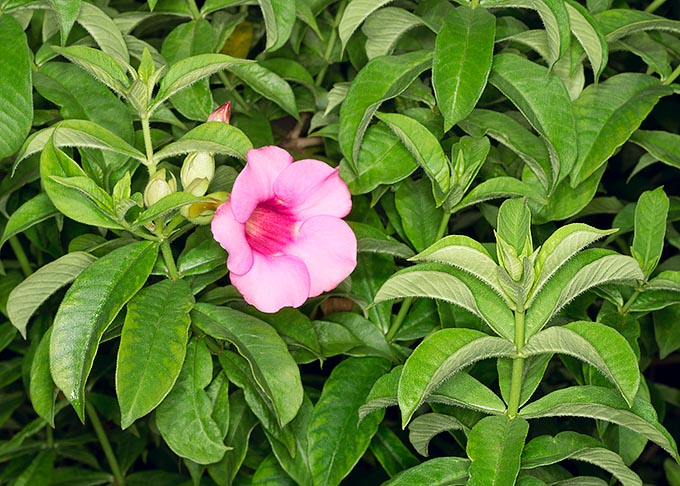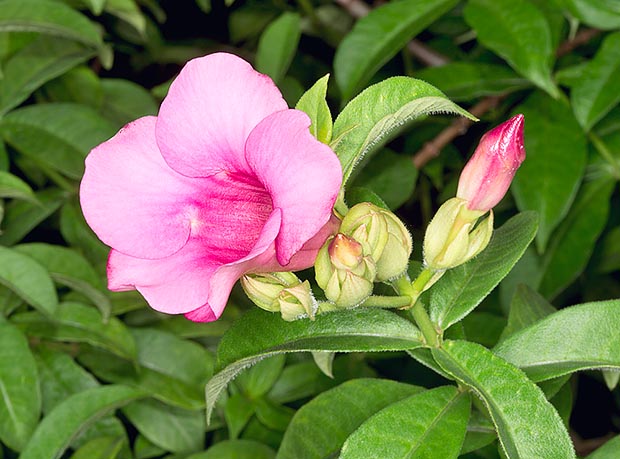Family : Apocynaceae

Text © Pietro Puccio

English translation by Mario Beltramini

Allamanda blanchettii is a 3 m sarmentose cultivable as espalier or as bush © Giuseppe Mazza
The species is native to north-eastern Brazil (Alagoas, Bahia, Ceará, Maranhão, Paraiba, Pernambuco, Piauíe, Rio Grande do Norte and Sergipe) where it grows in the dry forest, locally known as caatinga.
The genus was honoured by Linnaeus to the Swiss naturalist Frederick-Louis Allamand (1736-1803) scholar of the Brazilian flora; the species is honoured to its collector, the Swiss botanist and naturalist Jacques Samuel Blanchet (1807-1875).
Common names: cherry allamanda, purple allamanda, purple trumpet flore, violet alamanda (English); alamanda-de-jacobina, alamanda-rosa, alamanda-roxa, quatra patacas (Portuguese-Brazil).
The Allamanda blanchetii A.DC. (1844) is an evergreen sarmentose shrub with milky sap, up to about 3 m tall, with young tomentose branches and simple coriaceous leaves, sessile, arranged in verticils of 3-5, oblong to oblong-elliptic with pointed apex, 5-11 cm long and 2,5-5,5 cm broad, of glossy green colour on the upper page, opaque below. Cymose terminal or axillar inflorescences carrying numerous bisexual flowers, on an about 1 cm long peduncle, opening in succession, with 5 pubescent oblong sepals with pointed apex, campanulate corolla, 6-9 cm long and of 5-6,5 cm of diameter, with 5 rounded lobes partially overlapped, of pink to reddish purple colour, more intense in the throat. The species is auto-incompatible, it needs therefore the crossed pollination for fructifying.
The fruits are globose and spiny follicles containing numerous flattened seeds equipped with a membranaceous wing.

6-9 cm long and 5-6,5 cm broad campanulate corolla. Toxic latex but medicinal virtues © Giuseppe Mazza
It reproduces by seed, which germinates in 3-6 weeks in organic loam, with addition of sand or perlite in order to improve the drainage, kept humid at the temperature of 22-24 °C, and by cutting and by layering.
Vigorous and fast-growing species, with prevailing blooming in summer and autumn, of which have been selected numerous varieties with colours of different tonality, very appreciated and frequently cultivated in the tropical and subtropical gardens; it can stand drops of temperature up to some degree over the 0 °C only if exceptional and for a very short period.
It requires full sun for getting a best blooming, or at the most a slight shade, and draining soils acidic or neutral; the waterings must be regular and abundant, avoiding the stagnations, even if well rooted it bears short dry periods, is often grafted on Allamanda cathartica which has a more resistant rooting apparatus.
It can be bred as bush or leaning against a wall or a grating, the prunings are useful, to be made by late winter, early spring, for getting a more compact habit and a copious blooming. Where the climate does not allow a continuous permanence in open air, it can be cultivated in pot utilizing a aerated and draining loam rich of organic substance, with regular irrigations and fertilizations during the summer months, using products balanced with microelements, to be sheltered in winter in a very luminous location with temperatures as an average over the 16 °C and keeping the loam just humid.
The roots and other parts of the plant are utilized in the traditional medicine for various pathologies. All the parts of the plant are toxic and the latex can cause dermatitises and allergic reactions to particularly sensible persons.
Synonyms: Allamanda violacea Gardner (1844).
→ To appreciate the biodiversity within the APOCYNACEAE family please click here.
